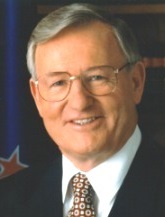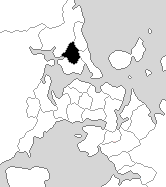Related Research Articles

The 1996 New Zealand general election was held on 12 October 1996 to determine the composition of the 45th New Zealand Parliament. It was notable for being the first election to be held under the new mixed-member proportional (MMP) electoral system, and produced a parliament considerably more diverse than previous elections. It saw the National Party, led by Jim Bolger, retain its position in government, but only after protracted negotiations with the smaller New Zealand First party to form a coalition. New Zealand First won a large number of seats—including every Māori electorate, traditionally held by Labour. Its position as "kingmaker", able to place either of the two major parties into government, was a significant election outcome.

Whakatāne is a town located in the Bay of Plenty Region in the North Island of New Zealand, 90 kilometres (56 mi) east of Tauranga and 89 kilometres (55 mi) northeast of Rotorua. The town is situated at the mouth of the Whakatāne River. The Whakatāne District is the territorial authority that encompasses the town, covering an area to the south and west of the town, excluding the enclave of Kawerau District.

The 1993 New Zealand general election was held on 6 November 1993 to determine the composition of the 44th New Zealand Parliament. Voters elected 99 members to the House of Representatives, up from 97 members at the 1990 election. The election was the last general election to use the first-past-the-post electoral system, with all members elected from single-member electorates. This was the last time prior to the 2020 election where a party won an absolute majority of seats.

Anthony Boyd Williams Ryall is a former New Zealand politician. He represented the National Party in the New Zealand Parliament from 1990 to 2014. Between 2008 and 2014 he served as a cabinet minister, holding the posts of Minister of Health, Minister of State Services and Minister of State Owned Enterprises. He served previously in the Shipley Cabinet between 1997 and 1999. He announced in February 2014 that he was to retire from politics at that year's general election. He is chief executive of BestStart Educare, an early childhood education provider.

Bay of Plenty is a New Zealand electoral division returning one member to the New Zealand House of Representatives. The current representative is Todd Muller of the National Party, first elected at the 2014 election. He replaced Tony Ryall, also of the National Party, who retired after representing the seat since 1996.

Coromandel is a New Zealand electoral division returning one member to the House of Representatives. It is currently represented by Scott Simpson, a member of the National Party.

East Coast is a New Zealand parliamentary electorate, returning one Member of Parliament to the New Zealand House of Representatives. The electorate first existed from 1871 to 1893, and was recreated in 1999. The current MP for East Coast is Kiri Allan of the Labour Party, who has held office since 2020.
Port Waikato is a New Zealand parliamentary electorate which existed for four parliamentary terms from 1996 to 2008, and was recreated by the 2019/20 electoral redistribution ahead of the 2020 election. It was held by Bill Birch for one term, and by Paul Hutchison for the following three terms; both were members of the National Party.

Rotorua is a New Zealand parliamentary electorate, returning one Member of Parliament to the New Zealand House of Representatives. It was first established in 1919, and has existed continuously since 1954. The current MP for Rotorua is Todd McClay of the National Party, who won the electorate in the 2008 general election from incumbent Labour MP Steve Chadwick.
Kaimai is a former New Zealand parliamentary electorate, from 1978 to 1996. In 1996 the MP Robert Anderson was selected for the new seat of Coromandel, but retired due to illness, and was replaced by Murray McLean, who won the new seat.
Far North is a former New Zealand parliamentary electorate, which existed for one parliamentary term from 1993 to 1996, and was held by National's John Carter.

Glenfield was a New Zealand parliamentary electorate for four terms, from 1984 to 1996. It was represented by two members of parliament, first Judy Keall of the Labour Party, and then Peter Hilt of the National Party. Hilt defected to United New Zealand in 1995.
Eastern Maori was one of New Zealand's four original parliamentary Māori electorates established in 1868, along with Northern Maori, Western Maori and Southern Maori. In 1996, with the introduction of MMP, the Maori electorates were updated, and Eastern Maori was replaced with the Te Tai Rawhiti and Te Puku O Te Whenua electorates.
Te Tai Rawhiti was one of the five new New Zealand parliamentary Māori electorates created in 1996 for MMP. It largely replaced its English-named predecessor, Eastern Maori, though Te Tai Rawhiti's boundary was retracted significantly in the central North Island.
East Cape is a former New Zealand Parliamentary electorate, from 1978 to 1993.

The Bay of Plenty is a large bight along the northern coast of New Zealand's North Island. It stretches 260 kilometres (160 mi) from the Coromandel Peninsula in the west to Cape Runaway in the east. Called Te Moana-a-Toi in the Māori language after Toi, an early ancestor, the name 'Bay of Plenty' was bestowed by James Cook in 1769 when he noticed the abundant food supplies at several Māori villages there, in stark contrast to observations he had made earlier in Poverty Bay.
Matakana is a former New Zealand parliamentary electorate in the Thames-Coromandel District, which existed for one parliamentary term from 1993 to 1996, and was held by Graeme Lee. In 1994, Lee defected from the National Party to the Christian Democrat Party.
The Tāneatua Branch is a 25 kilometres (16 mi) long branch railway line in the Bay of Plenty, New Zealand, running from Hawkens Junction, west of Edgecumbe, to Tāneatua.
The mayor of Whakatāne is the head of the municipal government in Whakatāne District, New Zealand. The mayor presides over the Whakatane District Council, which was first formed in 1976 following an amalgamation, with further changes taking place in 1989.
Ōpōtiki District is a territorial authority district in the eastern Bay of Plenty Region on the North Island of New Zealand. It stretches from Kutarere and the eastern shore of Ōhiwa Harbour in the west to Cape Runaway in the north-east, and south from Ōpōtiki town up the Waioeka River into the Raukumara Range. Ōpōtiki District Council is headquartered in Ōpōtiki, the largest town.
References
- 1 2 McRobie, Alan (1989). Electoral Atlas of New Zealand. Wellington: GP Books. pp. 111f. ISBN 0-477-01384-8.
- 1 2 Part 1: Votes recorded at each polling place (Technical report). Chief Electoral Office. 1993.
- ↑ "Hon Tony Ryall". New Zealand National Party. Archived from the original on 28 July 2014. Retrieved 21 June 2015.
- ↑ Trevett, Claire (27 February 2014). "Health Minister Tony Ryall announces retirement". The New Zealand Herald . Retrieved 21 June 2015.
- ↑ Part 1: Votes recorded at each polling place (Technical report). New Zealand Chief Electoral Office. 1993. pp. 20f, 161.